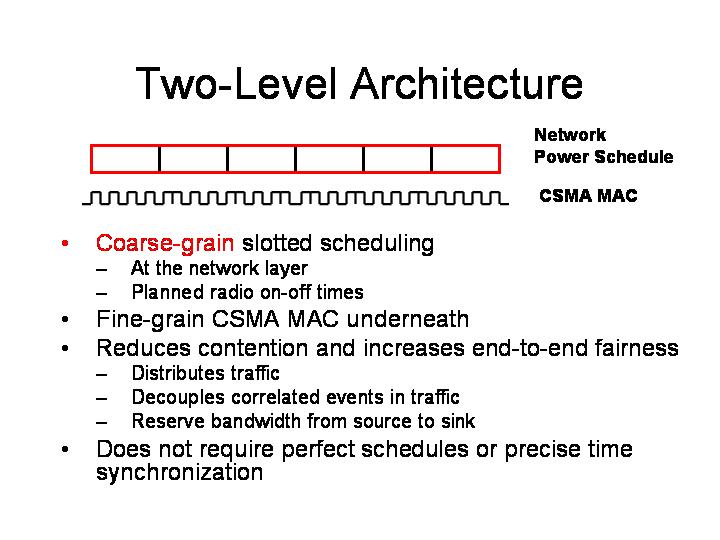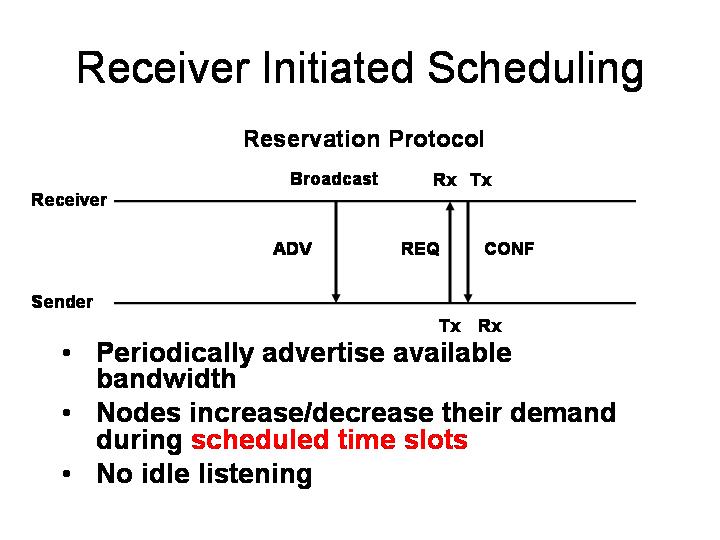Network Power Scheduling for Wireless Sensor Networks
Barbara Hohlt, "The Design and Evaluation of Network Power
Scheduling for Wireless Sensor Networks", [pdf] Computer Science Division UC Berkeley, PhD
Dissertation, May 2005. (UCB/CSD-05-1410
May 2005)
Network Power Scheduling applies radio scheduling algorithms and
resource reservation techniques to reduce
the power consumption of
motes in ad-hoc sensor networks. This research introduces a novel
two-level network architecture which combines coarse grain slotted scheduling
at the network layer with csma at the mac layer. The scheduling algorithm is
distributed and adaptive,
allowing schedules to change dynamically to changes in topology and
fluctuations in demand. Please see Algorithm Details, Chapter 3.4.
Our experimental results on 30-50 mote multihop testbeds show:
- Lower power consumption by a
factor of 4.6X over Low-power Listening
- Increased yields by 12% over
Low-power Listening
- 3X reduction in contention over using
CSMA alone
- 3-4x improvement in throughput
and increased fairness over using CSMA alone
Our contributions and novel
innovations include:
- A Distributed Algorithm for determining adaptive on-demand schedules in
multihop networks
- Two-level Architecture: time-division multiplexing (network layer) + csma (mac layer)
- Receiver Initiated Scheduling Protocol:
reservation of flows from source to sink
- CSMA congestion backoffs used to determine level of
contention in wireless networks
Flexible
Power Scheduling
a network
protocol for radio power scheduling in wireless sensor networks
Network Power Scheduling is a novel network architecture approach for reducing
radio power
consumption in wireless sensor networks through traffic scheduling. The
approach uses a decentralized algorithm, Flexible Power Scheduling (FPS), to
schedule entire traffic
flows,
not packets, at the network layer across multiple hops. The scheduling
is based on time-division at the network layer, rather than the MAC
layer, to achieve significant power savings, reduced contention, and
increased multihop throughput and fairness. FPS provides adaptive scheduling to support
changes in topology and fluctuations in demand (multiple queries and
aggregates). Energy savings are achieved
by powering down nodes during idle times identified through dynamic
scheduling. FPS is implemented in TinyOS and has been evaluated on two
real-world sensor network applications, TinyDB and GDI, and three
hardware platforms, mica|mica2|mica2dot. We show that a power
savings of 4.3x for a 35-mote TinyDB deployment can be achieved
compared with the existing power management of TinyDB (applicaton-level
duty cycling),
and a 160x power savings over no power management. In in-lab
experiments comparing GDI/fps with GDI/low-power-listening, FPS has
increased yields by 12% and lower power consumption by a factor of 4.6X
over low-power-listening.
We also present experiments that show a 3x reduction in contention, a
3-4x improvement for throughput for
multihop flows, and a significant
increase in fairness across multihop flows.
A talk on Network Power Scheduling .
Selected code available at SourceForge
TinyOS Project.
Scheduled Queuing and Buffer
Management: tinyos-1.x/contrib/ucb/tos/lib/BufferManager
tinyos-1.x/contrib/ucb/apps/TestQASend/
Pseudo-Random Number
Generation:
tinyos-2.x/tos/system/RandomMlcgC.nc, RandomMlcgP.nc
Papers:
- Barbara Hohlt and Eric Brewer. Network Power Scheduling for TinyOS Applications,
[pdf]
IEEE International Conference on Distributed Computing in Sensor Systems,
June 2006.
- Algorithm details in Chapter 3.4, "The Design and Evaluation of
Network Power
Scheduling for Wireless Sensor Networks", [pdf] Computer Science Division UC Berkeley,
PhD Dissertation, May
2005. (UCB/CSD-05-1410 May 2005)
.
- Barbara Hohlt and Eric Brewer. Twinkle: Network Power Scheduling
in Sensor Networks,
[pdf]
( UCB/CSD-05-1409,
April 2005).
- Barbara Hohlt, Lance Doherty, and Eric Brewer. Flexible Power
Scheduling for Sensor Networks, IEEE and ACM
International Symposium on Information Processing in Sensor Networks
April
2004 [pdf
],UCB/CSD-03-1293 January 2003.
Send Email to:
hohltb@CS.Berkeley.EDU


